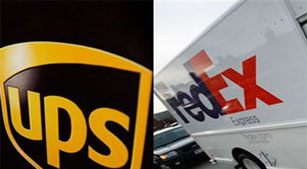Until the virus pandemic, ecommerce volumes in the US were clocking along at a very robust growth rates of 14-16% each quarter, year-over-year, according to Dept. of Commerce data.
Supply Chain Digest Says...
|
 |
Amazon in fact has created some 400 local delivery stations, where independent Amazon Delivery Partner firms can pick up parcels for that day's local deliveries. |
 |
What do you say? |
| Click here to send us your comments |
 |
| Click here to see reader feedback |
|
Then in Q2, ecommerce sales skyrocketed 44.5%, as stay at home consumers spent lots of time buying on-line.
That should be good for US parcels carriers such as UPS and FedEx, right?
Yes and no.
The rising parcel volumes have certainly been good for the shareholders of UPS and FedEx.
After falling from about $265 per share in mid-2018 all the way to about $107 in May, FedEx shares have soared to over $280 per share since then.
At UPS, the share price fell to about $94 per share in early May, but since then has exploded to about $174 per share this week.
But challenges for both companies abound. First, the soaring efulfillment business to consumers' homes now makes up majority and rapidly rising share of each carrier's parcel business – and those B2C shipments are much less profitable than its traditional business-to-business shipments.
In fact, home deliveries have jumped to about 70% of US parcel volumes for both UPS and FedEx, a sharp rise from pre-pandemic levels.
The lower profit margins on consumer deliveries come from both less revenue per package, and also higher costs, as consumer deliveries on average have far less "density” than B2B business.
In its Q1 earnings call, UPS said trucks delivering B2C made 15% more stops on their routes versus B2B, and delivered packages that were 33% lighter, which means less revenue per parcel.
But even more interesting, ecommerce is also a threat to the major parcel carriers business models. That's because retailers and others are positioning inventory at more locations to support next-day and same day delivering.
(See More Below)
|
CATEGORY SPONSOR: SOFTEON |
|
|
| |
|
|
By doing that, it opens up many more alternatives for retailers to get orders delivered to consumers, says Alan Amling, researcher at the University of Tennessee's Global Supply Chain Institute in the Haslam College of Business and a former UPS executive, writing last week in a guest column in the Wall Street Journal.
 That's because shorter local deliveries do not require the extensive air and ground networks UPS and FedEx have built to support longer parcel moves. That's because shorter local deliveries do not require the extensive air and ground networks UPS and FedEx have built to support longer parcel moves.
It makes it easier for a Walmart and of course already Amazon to manage their own local deliveries. And Ampling notes there are 228,000 couriers and local delivery-service businesses in the US that etailers could potential leverage for short haul ecommerce deliveries.
Amazon in fact has created some 400 local delivery stations, where independent Amazon Delivery Partner firms can pick up parcels for that day's local deliveries. Or retailers and others can offer in-store of curbside pick-up, with no local delivery requirements at all.
"Local fulfillment changes the game, undercutting the advantages of size and scale the big carriers enjoy in their national networks, raising important strategic questions for the package giants," Amling writes.
He notes that UPS and FedEx have highly efficient route-based systems optimized for two- to five-day delivery of ground shipments – and for now are not well equipped for the multiple trip requirements of on-demand delivery.
Do you see ecommerce as a threat to UPS and FedEx long term? Let us know your thoughts at the Feedback section below.
|